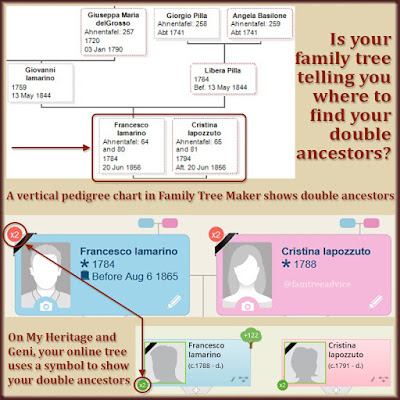Double ancestors reduce your allotment of direct ancestors.
In 2007 an historian from my grandfather's town gave me an ancestry surprise. My paternal grandparents were 3rd cousins.
Sure, I knew my grandparents had the same last name. My grandmother was born in New York. But I knew her father came from my Italian-born grandfather's hometown. But even Grandpa didn't seem to know the exact relationship. Or else he never wanted to tell us.
Two of my 3rd great grandfathers were brothers. That means their parents, Francesco and Cristina, are my double 4th great grandparents. They, and all their direct ancestors, appear twice in my pedigree chart.
This is what's known in genealogy as pedigree collapse. My grandfather Pietro married his 3rd cousin Lucy. They shared a set of 2nd great grandparents. So, instead of having 64 4th great grandparents (as we're all allowed to have), I have 62.
The amount of ancestors you have doubles for each generation. So we're all allowed 128 5th great grandparents. But because of double ancestors, I have 124 5th great grandparents. Notice the number of double ancestors also doubles with each generation. I have 2 double 4th great grandparents, and 4 double 5th great grandparents. I have 8 double 6th great grandparents, and so on.
There may be double ancestors hiding in your family tree. Here are 3 ways to find them.
1. Check Your Family Tree Chart
Your family tree, online or on your desktop, may point out your double ancestors.
- If you use Family Tree Maker, click the Publish tab and generate a Vertical Pedigree Chart for yourself. You may see some people in a dotted-line border. These are people who appear in your family tree twice because they're related to you in two important ways.
- If you use MyHeritage.com, look for people in your family tree with a red circle and "x2". This means this person is in your tree 2 times. They're related to you in 2 ways.
- As much as I dislike Geni.com, it also points out your double ancestors with a green "x2" in the lower left corner of a double ancestor.
- If all else fails, create a pedigree chart (direct ancestors only) and look for repeated people.
 |
| Check your family tree for hints that you have double ancestors. |
2. Color-Code Your Ancestors
This is how I'm using the relatively new color-coding feature in Family Tree Maker. I gave each of my 4 grandparents a unique color: yellow, pink, green, blue. This lets me see at a glance which branch any direct ancestor belongs to.
I find this to be the best and easiest way to spot double ancestors. So far, I have double ancestors on my father's side of the family tree only. The Iamarino family is from a small town in Italy. They had a good number of cousins marry, as well as siblings marrying siblings.
My double ancestors show up in the Index panel with 2 overlapping color dots. In the tree view, each double ancestor's color bar is split to show half yellow and half pink. The colors show they are the direct ancestors of my grandfather (yellow) and my grandmother (pink).
 |
| Color dots in the index and color bars in the tree view tell me which branch, or branches, an ancestors belongs to. |
3. Use Ahnentafel Numbers
Each of your direct ancestors has a very specific, unique number. The Ahnentafel numbering system follows a strict pattern. Run your Ahnentafel report from Family Tree Maker. Or do it manually (here's how). You may find that some of your ancestors qualify for 2 different Ahnentafel numbers.
I've created a color-coded ancestor spreadsheet with an Ahnentafel number in each cell. (Download one for yourself.) You can enter your ancestors into the chart and discover your dual-number ancestors.
On my ancestor spreadsheet, I'm giving double ancestors a blended color. Since Grandpa is yellow and Grandma is pink, I make their shared ancestors orange.
 |
| There's a strict method as to who gets which Ahnentafel number. They can help you find double ancestors. |
As they say in every sales pitch, "But wait! There's more."
These 3 techniques cannot show you your double cousins. My grandfather's paternal uncle married his maternal aunt. Their children are Grandpa's double 1st cousins.
This is the type of thing you'll find by accident, and it may confuse you at first.
My great grandfather was Francesco Iamarino. He had a brother Teofilo. Francesco married my great grandmother Libera Pilla. His brother Teofilo married Libera's sister Filomena. That created an extra joining of 2 families. The children of Teofilo and Filomena were my grandfather's maternal 1st cousins and paternal 1st cousins. Double cousins.
I've met relatives in Canada and in Italy who knew about the 2 brothers marrying 2 sisters. It was not unusual at all. Nearly everyone in my ancestral towns married someone who lived right nearby. If one merger of the Iamarino and Pilla families was a good thing, why not 2 mergers?
Going through vital records from Grandpa's town, I found another double wedding. On 20 December 1852, Damiano Marino and his sister Libera Marino married Rosa Zeolla and her brother Giovanni Pasquale Zeolla.
That was a very practical wedding. It's like the line in Hamlet: "Thrift, thrift, Horatio, the funeral bak'd-meats did coldly furnish forth the marriage tables." In other words, if you're gonna combine these 2 families, you may as well do it with 1 wedding feast and save money.
Can you find any pedigree collapse in your family tree? Do you think the marrying cousins knew they were cousins?




